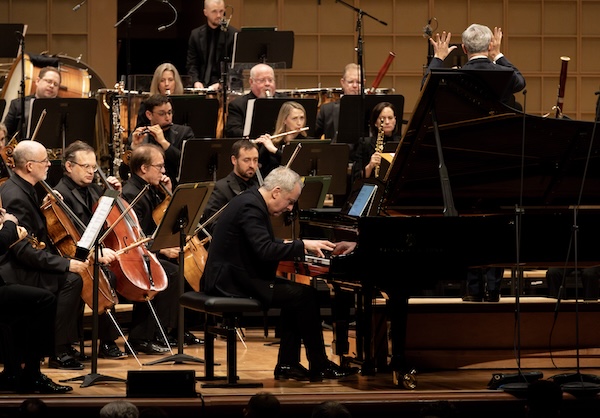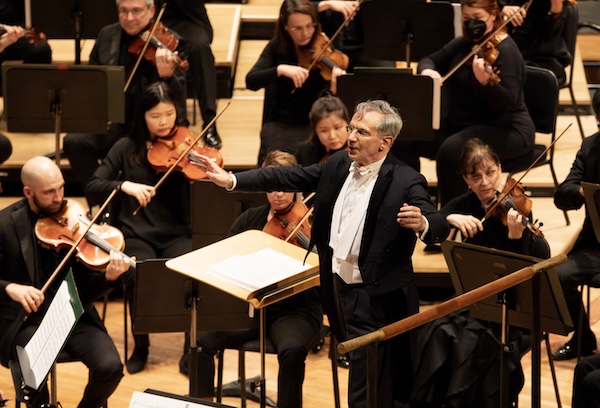With a concerto premiere, Dallas Symphony explores music about music

Fabio Luisi led the Dallas Symphony Orchestra Thursday night in a program that could be called “music about music.”
The evening featured the world premiere of ATLAS, a new piece for solo piano and orchestra by the English composer Anna Clyne. The Symphony No. 5 by Gustav Mahler was heard on the second half.
In her explanatory note, Clyne states that ATLAS draws its name and inspiration from the work of contemporary visual artist Gerhard Richter, specifically his four-volume collection of various photographs, drawings, prints and paintings from throughout his career.
Clyne calls ATLAS a piano concerto, but instead of using a more traditional formal structure, the four movements highlight individual allusions and references within and across their sections. The movements form complementary pairs; the first and third movements are vigorous, marked by rhythmic ostinati and prominent percussion, especially snare drum and wood blocks. The second and fourth movements are generally more lyrical and feature the piano more prominently, although the fourth movement grows more active over its course.
Pianist Jeremy Denk played almost continuously throughout the piece. Even the most idiomatically pianistic passages were often accompanied by other instruments as part of a larger effect. Virtuosic passagework, most frequently rapid parallel scale passages in both hands, tended to add color and sonic effect to material in the orchestra rather than standing out as opportunities for display. Indeed, the relationship between the piano and orchestra throughout ATLAS was more reminiscent of a complementary dialogue rather than dramatic musical conflict or competition
Musical allusions appear throughout ATLAS. Cascading piano arpeggios in the first and third movements remind one of Messiaen’s coloristic keyboard writing. The percussion ostinati in those same movements suggest jazz—a suggestion that is enhanced by a sudden walking bass line by the double-basses and a swing rhythm on a ride cymbal in the fourth movement. Broken chords by the piano in the second movement evoke the Moonlight Sonata, while a fugato in the fourth movement alludes to a brief quotation from the opening of C minor fugue of Bach’s Well Tempered Clavier.
The symmetry of tempos and characters in the movements coupled with the recurrence of distinct motifs and gestures prevents ATLAS from devolving into a random assortment of novel references. Like Richter’s collection of images, Clyne’s gathering of musical allusions invites the listener to engage with the piece based on the associations and juxtapositions of the materials featured.
That the premiere of ATLAS was received so enthusiastically Thursday night testified to the quality of the performance. Even without traditional solos, Denk was always at the center of the music, whether working in conjunction with the orchestra or being accompanied by it. His articulation perfectly captured the appropriate spirit of the music in the moment, whether alluding to salon music or to bebop.
The orchestra under Luisi’s baton easily fulfilled its side of the conversation, providing the needed support for Denk’s stylistic references while also including their own. The audience expressed their approval, bringing both Denk and Luisi out for three curtain calls following the conclusion of the piece.

Under Luisi’s direction, the Dallas Symphony Orchestra met the myriad challenges of Mahler’s Fifth Symphony with assurance. Luisi’s choices of tempo in the opening funeral march, particularly subtle tempo shifts between contrasting sections of the same movement, were exactly those needed to maximize the character of each allusion. Dynamics within and between such passages were also done in a way that heightened their impact.
Brass instruments figure prominently in the symphony and the entire brass section of the DSO distinguished itself. Principal trumpet Stuart Stephenson perfectly captured the solemn, ceremonial character of the opening fanfare and the funeral march that followed. Principal horn Daniel Hawkins imbued the obbligato horn part in the Scherzo with the appropriate alternation between jollity and ambivalence.
Luisi navigated the orchestra through the well-known Adagietto by giving each melodic phrase the slightest dynamic swell before diminishing just as delicately on the melodic resolutions, providing the movement with an especially satisfying combination of emotional fullness and restraint.
The finale provided a compelling climax to both the symphony and the evening. Starting at a moderate tempo, Luisi led the ensemble as he accelerated the pace of the movement steadily toward the breakout of the chorale melody by the brass that marks the high point of the piece. Volume, timbre and tempo all added up to an affirmation of spiritual triumph.
The program will be repeated 7:30 p.m. Friday and Saturday. dallassymphony.org